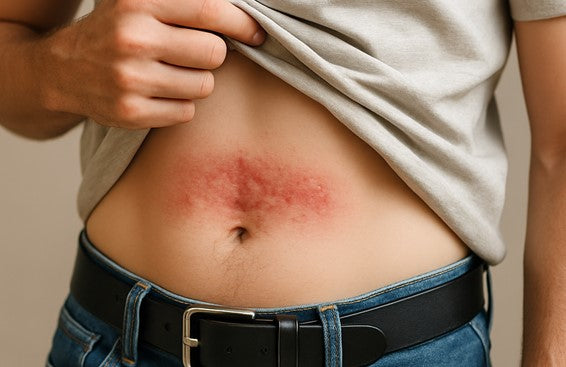My belt causes an allergy: why it happens and how to avoid it
Have you ever worn a belt and noticed itchy or irritated skin? If so, you might be experiencing a belt allergy. This increasingly common condition can be triggered by various factors, including the metals in the buckle or materials used in the belt.
Luckily, there are ways to prevent it from becoming a bigger issue, such as switching to buckle-free belts. Here's everything you need to know to avoid discomfort.
Why is my belt causing an allergy?
Belt allergy is a common skin reaction, especially when materials come in direct contact with your skin. Metal buckles are frequent culprits, known to trigger contact dermatitis. These metals react with the skin, causing itchiness, irritation, and discomfort. Repeated friction can make things worse and lead to recurring allergic reactions.
Other possible causes include the leather or synthetic materials in the belt, which may contain chemicals that irritate sensitive skin. If you’re prone to allergies, you're more likely to experience these symptoms.
Common symptoms of belt allergy
Think you might be allergic to your belt? Watch for these signs:
• Redness in the contact área
• Intense itching
• Small bumps or rashes
• Burning or stinging sensation
• Blisters or peeling
• Swelling in sensitive areas like the abdomen
We recommend switching belts immediately and seeing a healthcare professional to rule out more serious issues.
What metals cause belt allergies?
These are some common metals linked to belt allergies:
• Nickel
• Cobalt
• Chromium
• Zinc
• Stainless steel (in some compositions)
How to prevent or soothe a belt allergy
If you're allergic to your belt, the best approach is prevention. Identify and avoid materials that trigger reactions. An easy fix? Switch your belt—try one with a hypoallergenic buckle (like titanium or plastic) or go buckle-free with a Velcro-style closure. More comfortable, and no metal contact.
Already dealing with a reaction? Remove the belt immediately and apply a soothing cream or ointment. Talk to your doctor or pharmacist about the best treatment. Cold compresses can help reduce itchiness and swelling. Avoid scratching to prevent making things worse.
Buckle-free belts: the ideal allergy solution
As mentioned, one of the most effective solutions for belt allergies is going buckle-free. These innovative belts skip the traditional metal buckle, the usual source of allergic reactions.
Instead, they use Velcro or other non-metal closures, offering a secure and comfortable fit with zero risk of metal exposure.
If you’ve realized your belt is giving you allergies, you’re not alone. By understanding the causes and symptoms and exploring these simple solutions, you can keep using belts—without discomfort.
Your well-being comes first!

